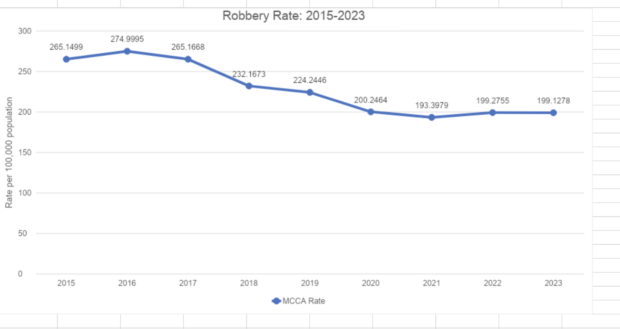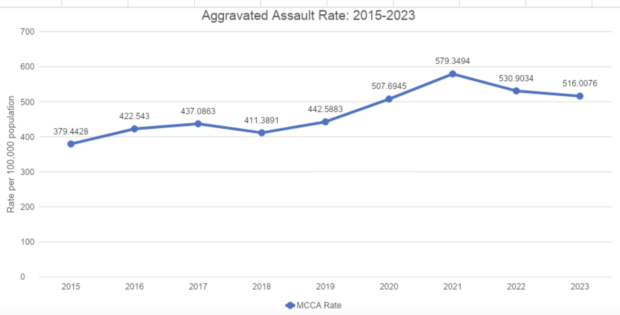FACT CHECK: Fact Checking Trump’s Claim About US Crime Statistics
During an Apr. 2 campaign rally in Michigan, presumptive 2024 Republican presidential nominee and former President Donald Trump claimed U.S. crime statistics are “only going up.”
Verdict: Misleading
Both data from the Federal Bureau of Investigation (FBI) ‘s website and multiple experts indicate Trump’s claim is false. However, some experts suggest that there is not enough data to make a specific determination.
Fact Check:
New York Judge Juan Merchan rejected Trump’s request to delay his trial over alleged hush money payments until after the U.S. Supreme Court rules on his claim of presidential immunity, according to USA Today. In an April 3 ruling, Merchan said Trump raised the presidential immunity argument “too late,” the outlet reported.
“In Venezuela, the crime is down 67% from what it was a year and a half ago. Because they’re taking all of their gangs and all of their criminals and they’re depositing them into the United States of America. Venezuela, think of it, their crime, wouldn’t we love to have a statistic where crime is down 67%? Ours is only going in one direction: [up],” Trump claimed during his April 2 rally.
The claim is misleading. According to data available via the FBI’s website, the rate of violent crime offenses per a population of 100,000 people was 380.7 in 2022 compared to 387 in 2021, and 398.5 in 2020. The same data indicates there was a total of 809,381 all violent crime incidents in 2022 and “951,270 offenses reported in the United States by 13,293 law enforcement agencies that submitted National Incident-Based Reporting System (NIBRS) data, and covers 75% of the total population.”
Likewise, quarterly FBI data examining violent crime percent change by region from the fourth quarter of 2022 to the fourth quarter of 2023 shows a 6% decline in violent crime. In addition, the quarterly data shows a 13% decline in murder, a 12% decline in rape, a 5% decline in robbery, and a 5% decline in aggravated assault for the same time period. The FBI declined to comment when contacted and instead directed Check Your Fact to this data.
A 2023 year-end report from the Council on Criminal Justice highlighting crime trends in U.S. cities produced similar findings. According to the report, the number of homicides decreased 10% from 2022 to 2023, “representing 515 fewer homicides” among the 32 cities included. The total annual homicide rate per 100,000 people was 12.7 in 2023, compared to 14.2 in 2022.
Despite the overall decrease in homicides across the U.S., however, homicide rates for individual cities varied, with increases noted in Syracuse (35%), Memphis (24%), and Seattle (12%) and decreases noted in New York (12%), Los Angeles (14%), and Philadelphia (21%), among others.
Furthermore, the same data shows aggravated assault decreased 3% from 2022 to 2023. The total annual rate of aggravated assault in 25 cities was a rate of 241.2 per 100,000 people in 2023 compared to 247.4 in 2022. According to the report’s Figure 20, which shows percent change in crime from 2019 and annual rates from 2019 to 2023, Syracuse’s annual aggravated assault rate was 606 per 100,000 people in 2023 compared to 660 in 2022. Similarly, Seattle’s annual aggravated assault rate was 438 in 2023 compared to 471 in 2022.
The carjacking rate, which is representative of 10 cities, also decreased 5% from 2022 to 2023, with the data showing a total annual rate of 12.3% per 100,000 people in 2022 compared to a rate of 11.7% per 100,000 people in 2023. According to Figure 20, Memphis had a carjacking rate of 58.3 in 2023 compared to 68.8 in 2022. Similarly, Los Angeles had a carjacking rate of 13.0 in 2023 compared to 14.0 in 2022.
Alternatively, the robbery rate increased 2% from 2022 to 2023 with the data showing a rate of 203.0 per 100,000 people in 2022 and a rate of 206.4 per 100,000 people in 2023. Figure 20 shows Baltimore had a robbery rate of 761.5 in 2023 compared to 750.4 in 2022. Chicago also had a higher robbery rate in 2023 at 409.7 compared to 336.4 in 2022.
Citing a quote from the same report in a Jan. 25 article, Forbes noted that “even in cities where homicide has returned to pre-2020 levels, it is still intolerably high, with some 20,000 lives lost to intentional violence last year.” (RELATED: Has Biden Not Been To Wisconsin In Two Years?)
Multiple experts told Check Your Fact Trump’s claim is inaccurate.
Clark Neily, senior vice president for legal studies at the libertarian Cato Institute, told Check Your Fact that Trump’s claim is “incorrect.”
“‘Crime’ is notoriously difficult to define and track, but we can say with a high degree of confidence that Trump’s assertion that crime in America is only going up is incorrect. Violent crime—including homicides—has definitely been down over at least the past 18 months, although it is still above 2014 lows after peaking in 2020,” Neily said and pointed to an FBI graph.
“It’s more difficult to say whether the overall crime rate (including property crimes) is up or down during the past 18 months, but my sense is probably slightly down. But again, there’s certainly no basis for the assertion that ‘our crime rate is only going up,'” Neily added.
Dr. Charis Kubrin, a criminology expert at the University of California, Irvine’s School of Social Ecology, also labeled Trump’s claim as false, stating that crime is dropping.
Kubrin said Trump’s statement is “generic,” and it is unhelpful to make such a statement without qualifying it since crime is a complex issue with variability.
“There is so much variability. Are we talking about the recent past, the last few weeks, months, or years? Is crime up or down compared to what? There’s none of that nuance in that statement. It is troubling then, to claim that crime is only going up, because it implies this is happening across the board and it’s a universal trend. If we’re going to talk overarching themes, the exact opposite is the case. Violent crime is going down,” Kubrin explained.
Kubrin added that violent crime, particularly homicide, has been dropping since the COVID-19 pandemic in 2020. Despite violent crime going down across the U.S., “there will always be outliers that buck the national trend,” she noted, citing examples such as Washington, D.C. and Seattle.
When asked what could be causing violent crime to drop in the U.S., Kubrin said experts don’t necessarily know.
“There’s not one generic answer, because it is a relatively new decline. It’ll take awhile to figure out if this is short-term or long-term or if we’re going back to stasis, and it’s still too soon to determine that.”
Alternatively, Kubrin did not hesitate to comment on the “gap” between what crime data shows and what Americans perceive about crime rates.
Kubrin said a Feb. 12 NPR article about violent crime dropping is “important.” The article, Kubrin said, highlights the gap between “what we know and what we think we know.”
Dr. Edward Maguire, a criminal justice expert at Arizona State University, agreed that crime rates are dropping.
“Crime rates in the U.S. increased dramatically during the pandemic and then they began to drop. Last year (2023), crime rates dropped significantly in the United States. For the FBI’s eight ‘Part 1’ crimes, crime rates dropped in every category except motor vehicle theft. The 13.2% reduction in national homicide rates was especially noteworthy, but there were also reductions in rapes, robberies, aggravated assaults, burglaries, larcenies, and arson cases. Polling data suggest that many Americans believe crime is increasing when in reality, overall violent crime rates and property crime rates are decreasing,” Maguire said.
Samuel Peterson, a policy researcher at the nonpartisan RAND Corporation, offered a different perspective.
“Comparisons across countries can be difficult due to different definitions and data collection mechanisms. This also makes it hard to compare crime number by city or state. Another thing to consider is that crime is very local, so national trends smooth over all of the local variation,” Peterson said.
“Also, we don’t have a great picture of crime nationally currently due to the transition to NIBRS and low rates of reporting by police agencies to the FBI. Another source is the Major Cities Chiefs Association, which collects annual crime totals from 58 large cities in the U.S. (not representative). While the data reported by the agencies are not always final, the numbers won’t change too much,” Peterson added.
Peterson also provided Check Your Fact with crime data he compiled based on cities that reported complete data between 2015 and 2023 with the rates based on their 2020 census populations. The data represents homicide, robbery, and aggravated assault.

Credit: Samuel Peterson, Analysis of Major Cities Chiefs Association Violent Crime Reports, 2015-2023. RAND: Santa Monica, CA

Credit: Samuel Peterson, Analysis of Major Cities Chiefs Association Violent Crime Reports, 2015-2023. RAND: Santa Monica, CA

Credit: Samuel Peterson, Analysis of Major Cities Chiefs Association Violent Crime Reports, 2015-2023. RAND: Santa Monica, CA
“These data are based on the cities that reported complete data during the 2015-2023 period and the rates are based on their 2020 census populations,” Peterson said of the data.
“I’ve seen others make the statement that crime is up from before 2020, but is trending downward since 2021. That seems to roughly hold here, although robberies have been declining and flattened during that period. The homicide figure includes a national comparison from CDC WONDER multiple cause of death homicide rates,” he added.
CNN labeled Trump’s claim as false via an April 3 article.
Check Your Fact reached out to the Trump campaign for comment and will update this piece accordingly if one is received.
